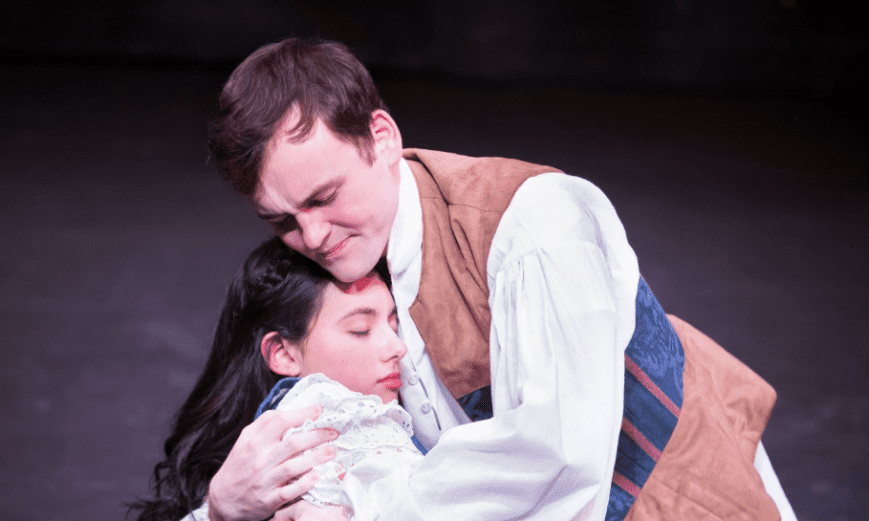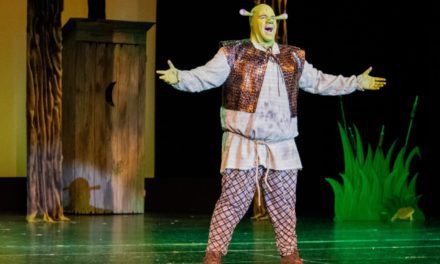PROVO — Romeo and Juliet is one of the most timeless plays ever written because of its focus on two of the most basic human emotions: love and hate. But a new adaptation for young audiences at BYU, Romeo y Julieta, updates the story by changing the Capulets to the Hispanic Capuletos, thereby adding a dimension of cultural misunderstanding as a cause of the tragedy of the star-crossed lovers. In an era of increasing cultural diversity, this adaptation makes the story more pertinent to contemporary life without ignoring the play’s emotional core.

Show closes February 17, 2018.
Director Julia Ashworth took a risk in creating a bilingual Romeo and Juliet. After all, Shakespeare can be difficult to understand; adding another language could create new hurdles for audience members. Yet, the script changes (adapted by Ashworth, with translation adaptation by Emily Dickerson, Mariah Eames, and Amelia Johnson) and bilingualism did not make the story more challenging to follow. Ashworth and her team used several tricks to help monolingual audience members, such as translations of Spanish dialogue, or replies in English that made it easy to guess what the Spanish speakers were saying.
Ashworth also knows how to create staging that is appropriate for young children. To accommodate short attention spans, the scenes move quickly and often had live music or frequent movement to prevent stagnation. I also appreciated how Ashworth kept her actors on stage the entire performance; when not performing, the actors were attentively watching the scene from the sides of the stage and modeling good audience behavior. Finally, Ashworth created an appealing party scene at the Capulet residence, and the colorful, energetic movement made it the most memorable scene of the play.

Rachel Leishman as Julieta. Photo by Savanna Richardson.
Maximillian Wright plays Romeo as an eager, decisive young man. Refreshingly, Wright avoids making Romeo whiny and mopey, possibly because any mention of Rosalind is eliminated from this 60-minute version of the script. Wright also easily slipped into a comfortable infatuation with Rachel Leishman, who played Julieta. Leishman makes Julieta young and curious about her surroundings. That inquisitiveness is why it was believable that Julieta would fall in love with Romeo. Leishman and Wright seem devoted to each other, and that strong romantic relationship made the production succeed.
Another strength in the cast was Amelia Johnson, who played El Ama (the nurse) and Lady Montague. Johnson made the nurse’s despair after the death of Teobaldo (Tybalt, in traditional versions) almost palpable, and it was easy to feel empathy for all the Capuletos. I also enjoyed her no-nonsense Lady Montague for the feminine power that she projected on stage. (Johnson’s vague resemblance to Wright also made it believable that they were mother and son.)

Maximillion Wright as Romeo. Photo by Savanna Richardson.
On the other hand, Sariah Lyles and Nikole York were both miscast as Mercutio and Benvolio, respectively. By having these male characters played by women, the masculine buddy relationship in the script (still easily recognizable today) is lost completely. Additionally, York was stiff in many of her scenes, and Lyles was too small to make her swordfight with Daniel Mesta (in the role of Teobaldo) convincing as a life-or-death struggle. Mesta is about 5 inches taller and much more muscular than Lyles; if Teobaldo were really giving full effort to the fight, he would have overpowered Mercutio within seconds. Indeed, casting just two male actors in this Romeo and Juliet was probably more challenging to this production than the bilingualism was.
The set for this touring production (designed by Rory Scanlon) consisted of five vertical banderoles decorated on both sides to represent the various settings of the play. The colorful Renaissance patterns for the interior of the Capuleto home were delightful, and the simple Maltese cross on a brown background worked well for the cell of the abbess (a replacement for Friar Lawrence). The only problem with these set pieces was that the most used one tilted and failed to stand upright for most of the performance. The balcony, Juliet’s funeral bier, and any other furniture needed was represented by metal blocks, step stools, and metal planks. This made scene changes rapid, which helped maintain the flow of the play.

Left to right: Natlie Jennings as Señora Capuleto, Rachel Leishman as Julieta, Maximilian Wright as Romeo, and Amelia Johnson as Lady Montague. Photo by Savanna Richardson.
But the great visual strength of this production was the costuming, designed by Elizabeth Banks and Zoe Taylor. A clever mix of old and modern costume pieces reinforced the timeless setting of the play. The Capuletos wore costumes all inspired by the cultures of Latin America and Spain, which served as a constant reminder of their family’s cultural heritage. I especially loved the fashionable formal dress that Lady Capuleto wore, which communicated her high class status. Making her the only woman wearing high heels also communicated her wealth.
For all its changes, Romeo y Julieta is still recognizably Shakeseparean. Unlike many writers who update Shakespeare’s plays, Ashworth and her team have been very respectful of the Bard’s original words. The result is a nice production that honors Shakespeare while still teaching an important lesson about tolerance without getting heavy-handed or preachy. I wish the cast and crew well as they finish their run at BYU and then embark on an elementary school tour, where they will perform for an estimated 15,000 Utah children.
Donate to Utah Theatre Bloggers Association today and help support theatre criticism in Utah. Our staff work hard to be an independent voice in our arts community. Currently, our goal is to pay our reviewers and editors. UTBA is a non-profit organization, and your donation is fully tax deductible.






